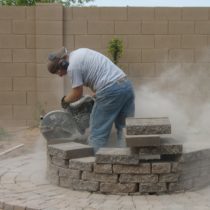Landscape Architecture for Landscape Architects › Forums › GENERAL DISCUSSION › GIS vs Google Earth warning
- This topic has 6 replies, 4 voices, and was last updated 5 years, 6 months ago by
Anonymous.
-
AuthorPosts
-
November 10, 2017 at 2:44 pm #194336
 Leslie B WagleParticipant
Leslie B WagleParticipantMaybe I’m way behind most of you in discovering the extent of this….but I have relied on G.Earth to fill in some reality and even to draft details of sites into base sheets, but it was usually on fairly small parcels. Recently I ran into a situation where I had some GIS resources to rely on in creating a base sheet for a larger than usual property. However, the GIS source was intended more as a campus-type map and couldn’t offer much in the way of realistic parking lot outlines. This new base sheet had to be at a larger scale but was not needed for great accuracy itself, just as more of a location guide for landscape features to be added. So the expense of getting a real survey wasn’t justified. Still, I wanted it to be fairly realistic so I drafted what I could from Google images at the chose scale for use over the GIS (probably USGS) topo, referring to pond locations and highway lines to get them to “register” with each other.
This worked about as well as needed but towards the bottom of the sheet I couldn’t resolve a discrepancy and faced deciding between the aerials and GIS sources. I finally decided in favor of the GIS although part of me felt like the camera couldn’t be that wrong. Well, it turns out that yes it can be. I’m not sure I understand all the terms and processes in this discussion between geographers, but I’m passing it along.
http://freegeographytools.com/2007/positional-accuracy-in-google-maps-my-maps-vs-google-earth
My client is happy enough. But in moving past the “vicinity map” level into a “master reference map” or other use, it just seems like the best idea would be instead of showing fixed scale, to say something like “Information drawn from several sources and scale is approximate,” or similar wording, in case somebody tries to re-use it.
-
This topic was modified 6 years, 8 months ago by
 Leslie B Wagle.
Leslie B Wagle.
-
This topic was modified 6 years, 8 months ago by
 Leslie B Wagle.
Leslie B Wagle.
November 12, 2017 at 1:27 pm #195573 Andrew Garulay, RLAParticipant
Andrew Garulay, RLAParticipantI keep “Plan Notes” text on all of my plans that has some variation of “THIS LANDSCAPE PLAN IS BASED UPON PLANS BY OTHERS, TAPE MEASURING ON SITE, AND NOT FROM INSTRUMENT SURVEY. THIS PLAN IS SOLELY FOR THE PURPOSE OF LANDSCAPE PLANNING AND SHOULD NOT BE USED FOR ANY OTHER PURPOSE. LOT LINES ARE APPROXIMATE.”.
Another really good source for images and topography is NOAA ( https://www.coast.noaa.gov/dataviewer/#/ ). The topo can be downloaded in dxf form. If you can get coordinates of the site it matches up very well. I know land surveyors who compare it to their on the ground surveys and they say the accuracy is very good. I have not put the images to the test. Once you understand how to have it exported for what works best for you it is very easy to use.
November 13, 2017 at 12:12 pm #197172 Leslie B WagleParticipant
Leslie B WagleParticipantThat is a great condition of use statement. Unfortunately when I tried the NOAA, their photo had even more leafed out forest and I couldn’t see as much of the pavement edges as from google, bing, etc. Fortunately, topo was good enough from their GIS to go ahead. I just somehow thought that those aerial sources would had “stiched” overlapping photo coverage in a way that compensated for any warp around the edges from center of camera (my primitive way of expressing it) but wanted to warn others it’s not so great. You can tell that buildings are sort of “leaning,” but I guess I thought surfaces wouldn’t be distorted noticibly.
-
This reply was modified 6 years, 8 months ago by
 Leslie B Wagle.
Leslie B Wagle.
November 13, 2017 at 1:25 pm #197226 Andrew Garulay, RLAParticipant
Andrew Garulay, RLAParticipantI actually did a photo overlay from google earth last week on the project that is in my new avatar photo. It was very poor even on only a 3/4 ac lot to the point where I could not use it.
January 7, 2019 at 2:22 pm #3556885 Clayton MunsonParticipant
Clayton MunsonParticipantUsing the historical photo of from Google earth can sometimes help with the tree coverage issue. Look for a photo that was taken in the winter or shortly after construction to fill in the gaps that are not visible on a more recent aerial.
January 8, 2019 at 9:12 am #3556925 Leslie B WagleParticipant
Leslie B WagleParticipantActually this past weekend I was working in the same way on a large site, (massive existing hospital in fact) where again I expected the buildings to “lean” a little due to the multi story forms (showing small slices of the side walls), and I could get the ground features to stitch across 3 images… but when compared to an enlargement of an earlier historic line drawing, things just had to be compromised. I would think the line drawing was taken from something like missing original site plans but the photos were also “real,” yet didn’t mesh. This time tree crowns were pretty clear since there were fewer, from a drier climate location. But parking areas etc. just had to be representative, not literal. This will just be a base for planting upgrades so that’s okay but the same issue was there again. Something we just have to take into account and not over-rely on, if the nature of the project requires expensive construction type accuracy.
January 23, 2019 at 5:59 pm #3556980Anonymous
InactiveIf you need to be accurate, you have to have control of the data collection. GIS can be wildly inaccurate as well, it all depends on purpose of the data and entity that commissioned it. I create georeferenced drone photography for projects if a survey is not immediately available and have found it to be within .25 meters of a professional survey. Here’s the first one I did as a test of the technology.
-
This topic was modified 6 years, 8 months ago by
-
AuthorPosts
- You must be logged in to reply to this topic.

